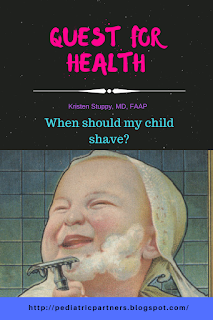 |
| Photo source: Wikimedia |
One of these questions: When is my child old enough to shave?
This is another question without a one-size fits all answer.
Girls and boys differ in needs and ages of puberty.
I told my own daughter that she could shave her legs when she needed to shave under her arms, since I know that under arm hair becomes longer during puberty, which is also when leg hairs thicken and grow. This just seemed like an easy answer to me. We are born with hairs on our legs, so deciding when those hairs are too long is tricky. It's not of a question of age, but one of quantity, color, and thickness of hairs.
When a boy starts to get visible peach fuzz on his upper lip it may be time to consider shaving, but it depends on the hair color, length, and his desires. Some schools include a "no facial hair" policy, which forces the issue.
Some kids are naturally hairier than others. Some have dark hair, others light hair. Puberty increases hair growth on the arms, legs, armpit, and in the groin in both sexes, and on the face in boys, but the age of puberty varies widely. Culture plays a part in the family's decision whether or not to shave body hairs.
The maturity of a child should be considered. A girl with thick, dark hair entering puberty at 9 years of age who is getting teased at school about her hairy legs might have a strong desire to shave, but if her fine motor skills are weak and she cannot safely handle a razor, it might not be appropriate for her to shave yet - at least not with a standard razor.
If a child has body hair that is bothersome and they want it removed but they are not able to safely use a standard razor, options might include other forms of hair removal, such as the chemical hair removal products, waxing, electric razors, or allowing a parent to help them shave. Each of these has it's own issues to consider.
Chemical hair removal products generally work by weakening the hair so that it is easily broken off at the skin level. Chemical products might lead to skin irritation or allergic reaction, but are well tolerated by most people. If you are planning to use it on the face, be sure to get a product specifically for the face and test a small area first to be sure they don't react to it negatively. Chemical hair removal products are relatively easy to use, can be done at home, and last for several days. Young children should be supervised so that the chemical does not get on other body parts or all over the bathroom...
Waxing is an option for many girls and women. It can also be used for boys and men, though is less commonly used by men. It's benefits are that it lasts several days and over time might cause the hair to grow in thinner (or not at all- which might not be a great idea for a boy who one day might want a beard). It can be painful, which might not be tolerable for some kids. You can go to a salon for a professional wax, but this is more expensive than the many do-it-yourself kits you can buy at local stores. You can look online for tips on how to find the best waxing product for your needs and how to wax.
Electric razors offer the benefit of a safer cut, but can take more time and often don't get as close to the skin as a standard razor. If your child is using an electric razor, (s)he must be warned about the hazards of using something electric next to a water source (such as the sink or tub). There are many types available, and I would recommend searching for reviews online prior to purchasing. Follow package directions on keeping the razor clean.
If you allow your child to shave with a razor be sure to get a new one just for that child. Never share razors, since this can lead to sharing of germs that cause infection. The choice of using a shaving gel or cream or just shower soap is a personal choice. Also talk about when to change the razor blade. It depends on how often (s)he shaves, how large of an area being shaved, and the body hair type. Someone with thick, coarse and curly hair that grows super fast will need more frequent blade changes than someone who is shaving fine peach-fuzz hair off every few days. Any blade that’s rusted must be changed immediately. When a blade feels like it’s tugging on the hair instead of gliding smoothly, it is time to change. If you’re using an older blade and notice nicks or rashes or razor-burn bumps, it's past time to change it. After each use a razor should be rinsed clean of all hairs and soaps/creams and allowed to dry. Don't lay it in a soap dish because it will stay wet. Wetness allows germs to grow and encourages rust, both of which are dangerous.
If you would be most comfortable shaving your child's skin, you can certainly try this with his or her permission. Be careful though, because if you nick the skin, you will never be forgiven! Kids are like that...
When it comes down to when it is the best time to shave, I think it is a very personal decision.

No comments:
Post a Comment